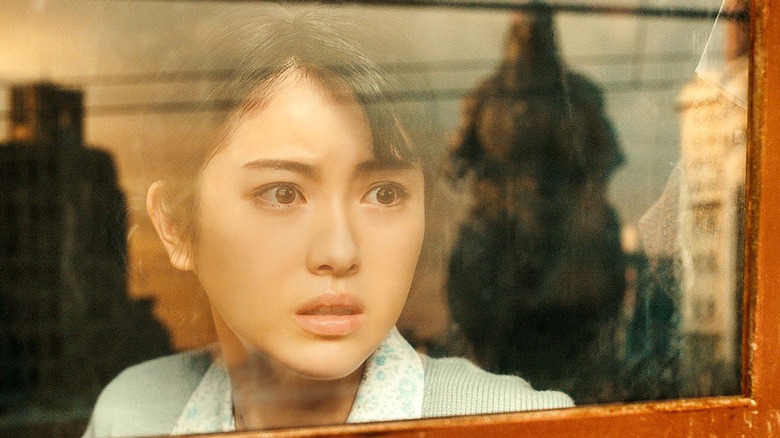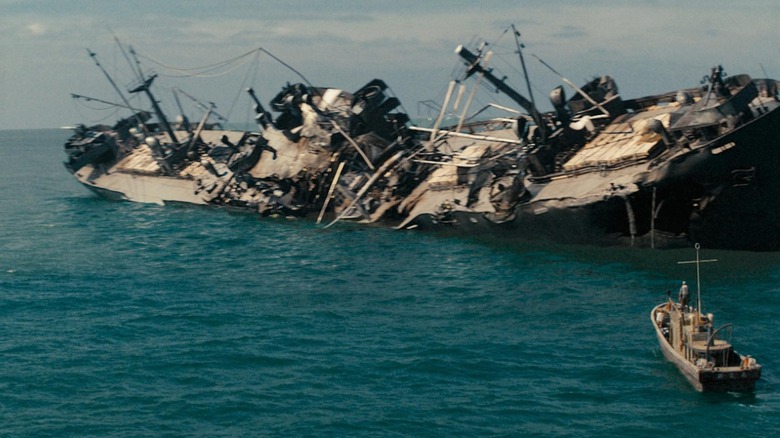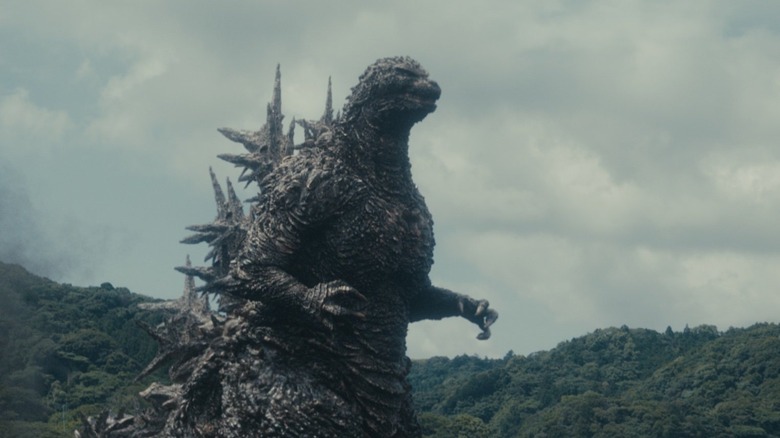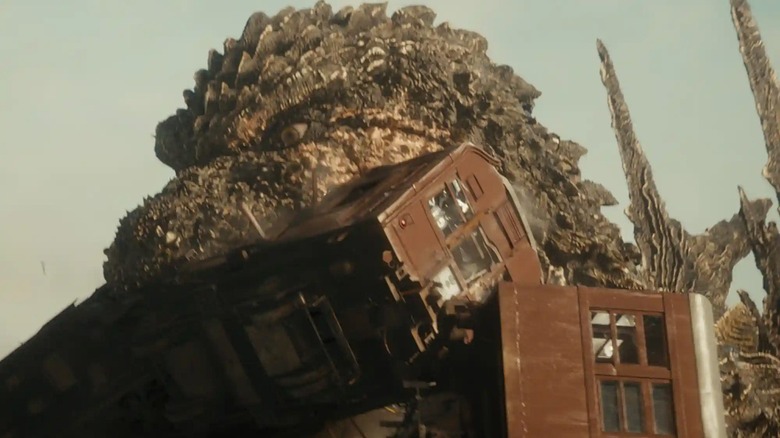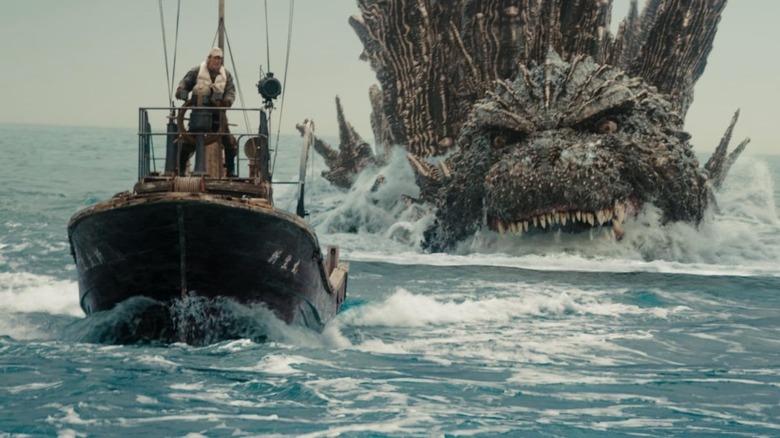Godzilla Minus One Is Chock-Full Of Easter Eggs Referencing The Original Classic
This article contains spoilers for "Godzilla Minus One."
It's a great time to be a Godzilla fan these days. Audiences across the globe get to have their pick of the litter, from the U.S.-based Legendary films that have since wrangled King Kong into the fray to the expansion of the Monster-Verse on Apple TV+ with the "Monarch: Legacy of Monsters" series to, of course, Japan's latest addition to the canon with "Godzilla Minus One." The film marks Toho's first big-screen effort since 2016's "Shin Godzilla," which didn't receive the same kind of wide release in the States that the 2023 film currently enjoys. But while most installments include various winks and nods to other movies in the franchise, "Minus One" stands apart from the pack thanks to certain creative decisions — ones that bring this newest film right in line with the 1954 original.
"Godzilla Minus One" contains several references, similarities, and homages to the classic "Godzilla" movie that forever changed the game — despite existing in its own continuity altogether. Written and directed by filmmaker Takashi Yamazaki, the story follows a group of Japanese protagonists reeling from the waning months and years of World War II, forced to contend with yet another existential threat arriving on their shores. Along the way, viewers are treated to blockbuster-sized spectacle, a harrowing tale of survival, and even a few twists on typical Godzilla conventions. And at every turn, it reinforces why this radioactive kaiju continues to stand the test of time, from the very first "Godzilla" movie to the last.
So it's only fitting that "Godzilla Minus One" features quite a few Easter eggs (both subtle and otherwise) referencing the one that started it all.
The atomic age
All these decades removed from the creation and implementation of the atomic bomb, the creative team behind "Godzilla Minus One" had to come together and figure out the best way to keep Godzilla relevant. They correctly intuited that bringing that action all the way back to the end of World War II and having the characters reckon with a defeated Imperial Japan was the best way to go about this. Although the original "Godzilla" took place during contemporary times in 1954, the film similarly contends with the fallout of the atom bomb — both thematically and practically, tying the monster's origins together with atomic testing.
"Godzilla Minus One" pulls a similar trick by making this a period piece and setting the story between 1945 and 1947, at the height of American nuclear warfare and subsequent testing. The immediacy of the game-changing weapon of mass destruction casts a profound shadow across the events of the film, detailed primarily through the shattered collective psyche of the island nation ... along with the fact that it inadvertently provides the fuel for the kaiju that's about to rise up from the depths of the ocean. Not only does this choice render Godzilla's rampage all the more terrifying, given that post-war Japan and its citizens are hardly equipped to deal with a threat of this magnitude, but it further strengthens the allegory of the original film.
Godzilla simply can't exist apart from nuclear war and while many modern films, both Japanese and American, have found alternative ways to contextualize what we find so appealing about the king of the monsters (read: spectacle), "Godzilla Minus One" reminds us that its initial radiation-infused origins are truly its most potent.
Local flavor
Protector, monster, myth, or something else entirely? Depictions of Godzilla have varied depending on the filmmaker (and studio) behind any given "Godzilla" picture, but setting "Minus One" at a point before the world at large has encountered the behemoth affords a unique opportunity. The very first sequence of the film puts a much more horrific twist on Godzilla's first real appearance in the original. Both movies settle on the exact same remote, far-flung locale of Odo Island as the staging ground for his initial rampage, and both instances lend a distinctly local flavor to the legend of Godzilla.
As in the 1954 "Godzilla," "Minus One" leans on the idea that Godzilla has been a known entity to villagers for an unknown amount of time and subsequently gave him his very name. In accordance with this new timeline, his introduction comes before he's been irradiated by nuclear weaponry. When fighter pilot Koichi Shikishima (Ryunosuke Kamiki) first lays eyes on Godzilla, he simply takes on the appearance of a massive animal that resembles a "dinosaur." Only later, during a brief snippet of the Operation Crossroads nuclear testing at Bikini Atoll (a sequence similarly depicted in a recent episode of "Monarch," in fact), does Godzilla grow larger, more aggressive, and fully mutated — implicitly suggesting that, had he never run afoul of mankind's meddling with powers beyond our control, the kaiju might've remained little more than a local legend and a subject of myth.
In both films, there's something poignant and powerful about the idea that Godzilla initially "belongs" to Japanese culture. Though hardly docile before, it's only after the rest of the world's interference (specifically the United States') that he transforms into a genuine killing machine. That's something to chew on right there, methinks!
Collateral callbacks
If there's one thing we know about Godzilla, it's that he's a force of nature. Commonly likened to acts of god such as hurricanes, floods, and other natural disasters, the kaiju also shares something else in common with these examples: nothing built by mankind can hope to survive his onslaught for very long. When Godzilla makes landfall on Tokyo later in "Minus One," fans were likely thrilled and delighted by the fact that director Takashi Yamazaki made his most overt reference yet to the 1954 movie.
In the original, Godzilla similarly attacks Shinagawa and all but levels the entire city. During the sequence, he makes mincemeat of a nearby trainyard, demolishes entire skyscrapers, and even finds the time to terrorize a small contingent of newscasters breathlessly reporting on the unprecedented destruction. Wouldn't you know it, but the kaiju follows a very similar path in "Minus One" — from setting his sights on a passing train (with main character Noriko on board, played by Minami Hamabe) to the conspicuous inclusion of another group of reporters caught directly in harm's way (and who meet an equally tragic end). It's safe to say that nothing about this nearly shot-by-shot recreation was coincidental.
Of course, this is also accompanied by the same use of the main theme from the original "Godzilla" — yet another loving callback, even in the midst of rampant collateral damage.
The power of the sea
There's a pretty good reason why "Godzilla" movies tend to set aside entire sequences and have them take place at sea. As an island nation, Japanese culture has always been influenced by the immense power of the Pacific Ocean, so why would Godzilla be any different? Traditionally depicted as rising from the sea and (eventually) returning from whence it came, the beast known as Gojira might as well be a living manifestation of all the ways the ocean can both provide life and take it away. So, once again, it's not exactly happenstance that the climax of both the 1954 "Godzilla" and "Minus One" revolve around killing Godzilla in water ... albeit in very different ways.
"Minus One" actually verbalizes this thematic idea with a line of dialogue late in the movie about using the "power of the sea" against the fearsome might of Godzilla. Where the original involved the use of a weapon of mass destruction to take down the giant kaiju (the infamous "oxygen destroyer"), "Minus One" opts for a canny mix of both wartime methods (Koichi repurposing the naval mines surrounding Japanese waters) and basic physics, plunging Godzilla to the depths of a nearby trench and hoping the immense pressure changes will kill him off. In both cases, the maritime setting of the final act comes loaded with all sorts of symbolism and meaning. Also, yes, it's hard to deny the lizard-brain joys of seeing a "Godzilla" movie essentially turn into "Jaws" for a prolonged stretch as Godzilla chases our main heroes in tiny boats. We'd be remiss if we didn't acknowledge that, too.
"Godzilla Minus One" is currently playing in theaters.
